The US government publishes something called the Greenbook (245 page pdf) which shows where all the US foreign aid goes, but you can get the same information on the website in a more useful and friendly way.
$38B in economic aid in 2010
This represents about 1% of the US national budget. There was $15B in military assistance, but will ignore that for now.
Going up for the last 10 years
Shown in the graph, aid was relatively flat at $15-20B (based on inflation adjusted 2010 dollars) between 1965-2000. The current level of $38B is where it was in 1953 time frame. For a good discussion on the trends of US foreign aid, look here.
Foreign aid goes to 180 countries
Aid gets scatter to almost every country in Africa, Eastern Europe, Latin America and Asia. Detailed data here.
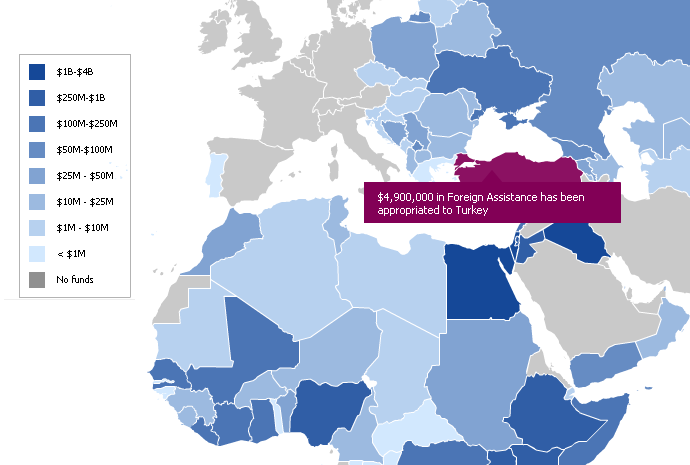
On the surface, seems somewhat evenly distributed
Without doing a “foreign aid per capita calculation”, Africa and Asia appear to get about 1/4 of the total spend. Latin American and Eastern Europe share less than 20% of the aid. The Middle East trails with 9% of spend. The non-region specific aid probably includes some SG&A overhead costs and generic assistance.
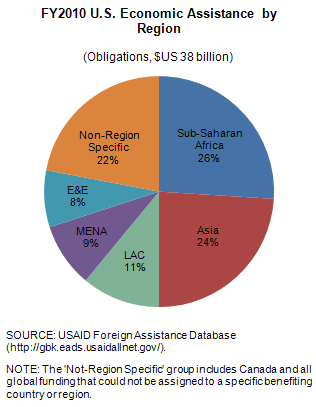 The Middle East number (9%) is understated
The Middle East number (9%) is understated
Since Afghanistan (#1 recipient) and Pakistan (#2 recipient) are counted in Asia. Also, Egypt (#5 recipient) is counted in Africa. Israel receives no economic aid, but instead receives $2.8B in military assistance.
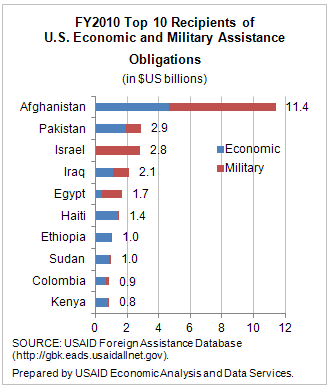
US foreign aid comes in many different forms
We build schools, provide drug therapies, dig wells, and even ensure fair elections. In the table below, you can see that US aid comes in 8 high-level buckets, with peace / security and health being the top two.
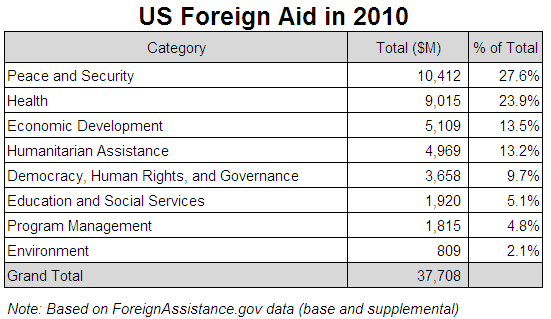
Each category can then be broken down
For example, the US spent $9B globally on health-related aid. The majority of this is spent on HIV/AIDS, compared to Malaria which only gets 1/10th of the funding.
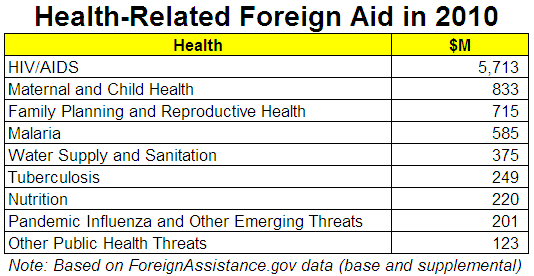
Poverty is everywhere
In this chart below, you can see that in rural India or Pakistan, more than 70% of the people live on less than 2 dollars per day. The Economist points out here that 1 bad harvest can completely wipe these people out.
Aid is generous, but inconsistent
One of the key elements of building trust is consistency. So, when I downloaded the foreign aid data on a few of our key frenemies (friend + enemy), I can see why they are a bit confused on whether the US is a friend or a foe. Download the entire data set (all countries, all economic aid, 1946-2010).
US gave $4.6B in economic aid to Afghanistan in 2010
This is more than we gave the country for 56 years from 1946-2002. Understandably, a lot of this has history mixed up with the cold war, but it is not surprising that they might feel America is trying to force a “all-of-a-sudden” type relationship.
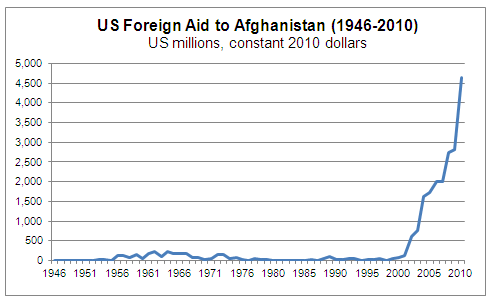 The US gave $1.9B in economic aid to Pakistan in 2010
The US gave $1.9B in economic aid to Pakistan in 2010
As you can see in the graph below, it looks like a yo-yo. It went from a high in the early 1960s, then dropped 90% to almost nothing in the early 1990s. Looks like a U shape and a U-turn in policy.
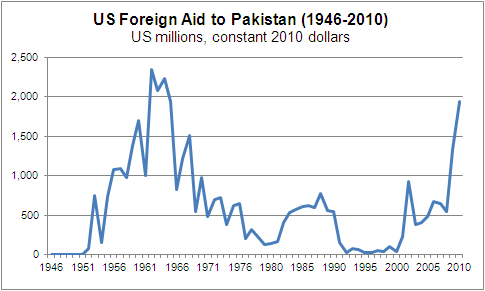
The US gave $1B in economic aid to Iraq in 2010
This is a lot of money – more than most countries receive from the US in aid – but it is only 1/8 of what Iraq received 2005. Digging deeper, it looks lie 2/3 of the “economic aid” was actually the Department of Defense helping out with “security assistance”. Does not sound very economic to me.
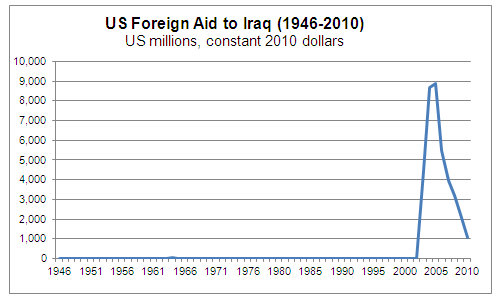
Mexico received about $622M in aid in 2010
We all too often forget our neighbor. US aid increased dramatically to Mexico, but in the form of more funding for narcotics control. If you read the news, the drug / gang violence in Mexico is at an all-time high.
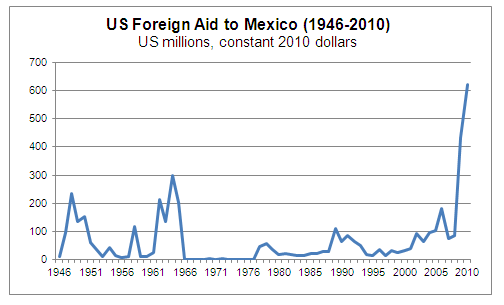
US government aid is just a part of the equation
A reader wisely pointed out that the US government makes up just a small portion of the larger US overseas philanthropy. Completely agree. Don’t have to look any further than the Bill & Melinda Gates Foundation, Kiva.org, or a local church to see that Americans are eager to assist and invest in the developing world. Thanks for pointing that out.
US private capital flows were $161B in 2010
That is more than 4x more than what the US government sends overseas for development assistance. Look at this report from the Hudson Institute that shows how the contributors to overseas philanthropy are changing.
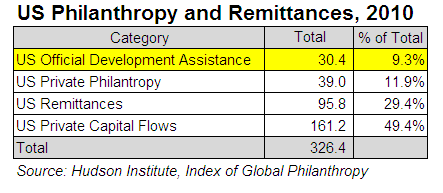

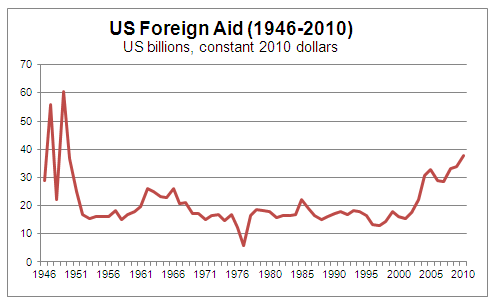
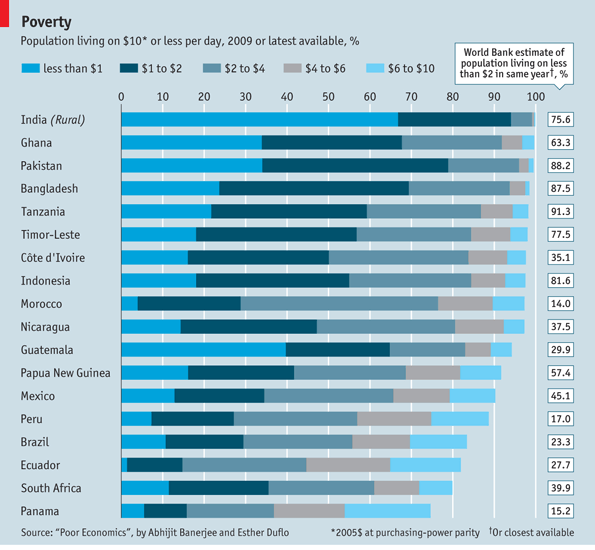
This is very informative. However, you only show us part of the picture. You show us US government aid (ODA) but you do not take into account private foreign aid from foundations, corporations, religious organizations ect.. This amounts to about 161 billion USD in 2010. ODA only represents about 9% of total US assistance with the developing world. This changes the nature of foreign aid. US ODA is slowly going obsolete and irrelevant. Here is an executive summary of how US foreign aid is changing and where I got my numbers from.
http://www.hudson.org/files/publications/2012ExecutiveSummaryIndexofGlobalPhilanthropyandRemittances.pdf
Kerry, thank you for that comment and push back. This post was written specifically about US government foreign aid, so I will make that more clear. The link you provided was excellent, will refer to it in the post itself.
Completely agree with you on the magnitude, importance and increasing trend of private overseas assistance. When I think back on the non-governmental organizations that I have read about, or have interactions with, it reminds me how flat of a world it is. How distance has shrunk, and how platforms now exist to connect supply (donors / technology / skills) with demand (recipients / opportunity / ambition).
Peter Drucker – huge fan of his – was a big believer in non-governmental organizations as the catalysts to truly help society progress forward. Governments had their day, then the corporations. Now there is a new vanguard.
The U.S. gives aid, financial and military, to over 150 nations, many to our enemies. We give over $200 Million to China? We give Mexico over $600 Million. Even though, Foreign Aid only represents 1% of the Budget, I would think poor hard working Americans, our injured Vets, our elderly, and our homeless could use the money. Maybe put some of the money and reinstate mental health facilities that closed, due to lack of funds, and get these people off the streets and back in hospitals where they belong. Of course in Washington`s culture, nobody tracts the money sent to foreign nations, once the money is handed over. We need to reduce funding.
Thanks for the comment. Agree that some of our direct aid seem at odds with our strategy. Depends a lot on your world view on the role of the US globally. That said, wonder if it is organizational inertia. Corporations fall into this trap. They take last year’s budget number, add / subtract 5%, then keep it going. Fascinating TED talk by Philips K Howard arguing that laws should sunset. They should not go on indefinitely. http://www.ted.com/talks/philip_howard.html Foreign aid, same thing? I edited 2 sentences, so it would fit. Hope that’s okay.